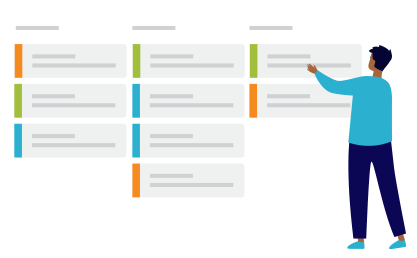When setting strategic goals and priorities for your organization, a Resource Manager or Project Manager can take some key steps to ensure success. There are many factors that can impact a project’s success, including budget, time, resources, employee availability, communication, organization and changing priorities. We will delve into each area and provide tactics to help projects achieve completion within your organization.
Budget
While research is necessary to properly budget for any new project, a successful Project Manager should have resources available to create more accurate and reliable budgets. Historical budget data is a valuable first step to determine a new project’s budget. It’s also important to have tools in place to be tracking resources and other costs incurred at any point during the project’s duration. With these tools in hand, Project Managers can make any necessary allocation changes to make sure projects stay within budget.
Tempus Highlight: Project Financial Management
Tempus’s Project Financial Management tools can help Project Managers create cost categories to control how financials are tracked and managed. Features including identifying capital spend versus expenses, costs versus revenue, planned or budgeted costs versus actual costs and a flexible API that can seamlessly integrate Tempus with a company’s financial reporting tools can help update and evaluate financial forecasts and how projects are keeping to budgets. Tempus can also layer material and other non-labor expenses, such as travel or hardware, with resource costs, or labor, costs related to your employees assigned to the project, to see the larger financial impact of the project.


Time
Any new enterprise-level priority or project request will come with a request for when it can be completed. It’s on the Project Manager to create the conditions and launch a project to ensure that the project meets its due date and stays on schedule while the Resource Manager ensures people are available to do the work. There are strategies to estimate time needed to complete a project. The first can be analyzing historical data of similar projects to understand how long a prior project took and any obstacles it met. Another tool is to talk to employees who might be assigned to the project to get a better understanding of their needs and estimates on how the work will get done. It can also help to pull resources who have experience on similar types of work, as they can be more efficient and meet deadlines more easily.
Tempus Highlight: Timesheets
Tempus Timesheets can assist all individuals on a project to work effectively by providing insight into what is budgeted, what projects are coming, and what work makes sense to prioritize at any given point. Additionally, when timesheet data is aggregated into a utilization report, the data can provide Project Managers with insight into employee availability and whether employees’ time is balanced, overbudgeted or under-allocated. Timesheets are also valuable to compare budgeted versus actual figures so that Project Managers can learn from past projects to impact future forecasts, and Resource Managers can look at historical data for more broad future budget planning and budgeting resources.


Resources
For a project to be successful, a Project Manager needs to consider the budget, time, and resources needed and should work with a Resource Manager to do that. Additionally, understanding what skills will be required of the resources assigned to the project, and who within your organization possesses those skills, will help create a team that you can rely on to get the project done within budget and time constraints. This is where resource management experience is pertinent, as it’s necessary to take a holistic view of the entire project portfolio, beyond task-based planning, and focus on how resources are being allocated and utilized throughout the organization, incorporating workload into the planning process. Resource management concerns the allocation of resources, with planning and modeling features to provide more control and visibility over your people.
Tempus Highlight: Skills & Competency Management
Within Tempus, there are tools to help you not just assign people to tasks, but to understand how to assign the right resources, who bring value and skills to the project. With Tempus’s central resource catalog, Resource Managers can manage any skills needed across the organization. Users can also create competency ratings for each skill to help identify competency gaps in the company and use those ratings when assigning people to projects.


Employee Availability
While in project planning stages, many people focus on budget and time. Equal focus needs to be given to evaluating employee availability, as that will be a key factor in your project’s success. It’s critical to know how many people are available to work on a project and if those people are the right people for the work. If there aren’t enough people with the right skills to do the work, or if they will already be busy with other projects, then it will be difficult (or even impossible) to get the project completed on time or to the required standard. A Project Manager must have a grasp on what skills will be needed to complete the required work, and Resource Managers need to have a holistic view of all projects currently taking place and those on the horizon so they can best allocate employees.
Tempus Highlight: Capacity Planning
Tempus Resource goes beyond assigning people to tasks. Tempus’s Capacity Planning provides solutions to see the big picture and take action to maximize productivity. By defining your team’s capacity per day, week or month, Resource Managers can easily answer these questions:
- When can this project start?
- Who has the ability to take this project on?
- Why is the team claiming they are too busy?
- What project(s) have to be deprioritized to get this new priority started?
- Will we need to make additional hires to get this project completed, if we determine there are gaps with the skills needed to complete the project and the employees with bandwidth available to complete the project?

Tempus’s heat maps, net availability, utilization reports and graphs paint the story in real time. With Tempus’s Portfolio Planner analysis, Project Managers can prioritize work and compare it to the team’s capacity. Resource Managers can answer questions such as when they will run out of full-time team members to complete the work, or when they need to look at outsourcing lower priority projects. Tempus can also create a visual representation of resource allocation with Heat Maps to make it much easier to spot staff that might be over or under-worked, so you can solve the problem quicker.

Communication
Projects often fail due to unclear objectives and milestones. It’s important for everyone involved in a project to know what the goals are, as well as what their individual role is in achieving those goals. If there is any confusion or misunderstanding about the project’s objectives, it can lead to problems down the line. It’s up to the Project Manager to make sure that everyone is on the same page and that everyone understands what is expected of them.
Tempus Highlight: Scribe
With Tempus’s decision management capability called Scribe, users can memorialize and capture key decisions made across the portfolio when using Tempus. Rather than having to track down information in various documents, emails or spreadsheets, Scribe helps share this information more broadly with everyone involved in your project. As Scribe is built into Tempus, users can collaborate with teammates directly in the platform by utilizing project comments, tagging, and notes. Scribe enables users to keep their communications about the project, related resources, and specific task questions in one space. If a resource got moved off a project, users can share the reasons easily in the feed. If a project’s end date is extended, or milestone dates are updated, details can be shared in the project comments area and users can tag team members who need to see the updates, including timestamps for tracking when updates are made. This tool is designed to facilitate communication and collaboration among all individuals involved with your project.

Organization
Once a project begins, it can be easy to focus on simple tasks, rather than zoom out to see what’s required to keep the project moving forward and manage all individuals on the project. It’s essential to have a resource management software to help all employees track time, progress and incoming requests on the same platform.
Tempus Highlight: Portfolio Kanban
Using Tempus’s Kanban can help provide Project Managers with a visual understanding of all the moving parts of a particular project and provides an easily customizable interface to manage people, tasks and timelines.


Changing Priorities
It’s understandable that from the genesis of a great idea to the final phases of a project, a lot can change. What’s important is to have policies, communication strategies, and project management tactics in place to implement those changes and continue moving forward. In addition to sharing changes to priorities, deadlines and allocations with impacted employees, a Project Manager needs to have tools in place to help manage all moving parts.
Tempus Highlight: What If Analysis
Tempus’s What If Analysis modeling tool allows Project Managers to make informed decisions. Teams can run scenarios and plan more effectively when using What-If Scenario Planning, which provides options and answers about the ways forward and uncovers opportunities within possible disruptions. For example, previously lower priority projects may become viable, or teams may be revealed with more open capacity. Tasks and dependencies are useful for planning the details of a project. Being able to answer these questions – what happens if this critical person leaves the team? What is at risk if we are one person short? – provides much more potential for success.
What If analysis is also valuable to test hypothetical scenarios so you don’t have to commit the time, money and resources up front. You can see the effects of hiring more contractors or extending project deadline in real time, helping you make more informed decisions.

Project Managers can learn more why projects fail, including four famous project management failures and what can be done to avoid making the same mistakes, at: https://www.prosymmetry.com/blog/4-famous-project-management-failures.




